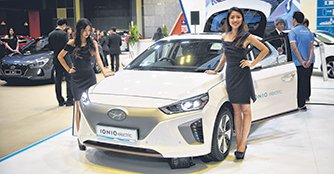Only electric cars will qualify for $20,000 tax rebate from July
06 Apr 2018|10,702 views
Motor traders are appealing for a revision to an emissions scheme which they deem too stringent. Come 1st July, only full-electric cars - which are costlier and in limited supply - will qualify for the top-tier rebate of $20,000 under the Vehicular Emissions Scheme.

To qualify for the $20,000 rebate under the new scheme, cars must have a particulate matter (fine soot) reading of zero. Currently, particulate matter, which measures carbon dioxide, carbon monoxide, hydrocarbons and nitrogen oxide levels of new cars, is not included.
As even the cleanest of cars with combustion engines will emit a small amount of particulate matter, none will qualify for the top-tier rebate. Some, however, will qualify for the second-tier $10,000 tax break, including a diesel-powered Renault.
Only pure electric cars, which do not have tailpipes, will qualify for the $20,000 rebate. Currently, the Hyundai Ioniq Electric is the only mass market electric model available here.
"Most cars will fall into the tax surcharge brackets from July," said Mr. Ron Lim, General Manager of Nissan agent Tan Chong Motors. There are two bands of surcharges - $10,000 and $20,000. These are worked into the car prices.
The Singapore Vehicle Traders Association, a body of parallel importers, has written to the National Environment Agency (NEA) to appeal against the zero limit on particulate matter. "We told them that it was too stringent, and impossible to meet," an association committee member said. An NEA spokesman said, "We have received the feedback from motor traders and will inform the industry should there be any change." Observers, however, said the NEA is unlikely to budge.
Meanwhile, the authority said it will monitor the new Worldwide Harmonised Light Vehicle Test Procedure, which Europe will implement on 1st September. Replacing the New European Driving Cycle, the new test is supposed to reflect emissions under real-world driving conditions.
The NEA spokesman said it has received feedback that some motor dealers could only submit emission reports based on the New European Driving Cycle. It is considering the option of accepting reports from both tests for a transition period before an eventual switchover to the new test procedure. With the new test, which is generally stricter than its predecessor, even fewer cars will qualify for tax rebates.
Motor traders are appealing for a revision to an emissions scheme which they deem too stringent. Come 1st July, only full-electric cars - which are costlier and in limited supply - will qualify for the top-tier rebate of $20,000 under the Vehicular Emissions Scheme.

To qualify for the $20,000 rebate under the new scheme, cars must have a particulate matter (fine soot) reading of zero. Currently, particulate matter, which measures carbon dioxide, carbon monoxide, hydrocarbons and nitrogen oxide levels of new cars, is not included.
As even the cleanest of cars with combustion engines will emit a small amount of particulate matter, none will qualify for the top-tier rebate. Some, however, will qualify for the second-tier $10,000 tax break, including a diesel-powered Renault.
Only pure electric cars, which do not have tailpipes, will qualify for the $20,000 rebate. Currently, the Hyundai Ioniq Electric is the only mass market electric model available here.
"Most cars will fall into the tax surcharge brackets from July," said Mr. Ron Lim, General Manager of Nissan agent Tan Chong Motors. There are two bands of surcharges - $10,000 and $20,000. These are worked into the car prices.
The Singapore Vehicle Traders Association, a body of parallel importers, has written to the National Environment Agency (NEA) to appeal against the zero limit on particulate matter. "We told them that it was too stringent, and impossible to meet," an association committee member said. An NEA spokesman said, "We have received the feedback from motor traders and will inform the industry should there be any change." Observers, however, said the NEA is unlikely to budge.
Meanwhile, the authority said it will monitor the new Worldwide Harmonised Light Vehicle Test Procedure, which Europe will implement on 1st September. Replacing the New European Driving Cycle, the new test is supposed to reflect emissions under real-world driving conditions.
The NEA spokesman said it has received feedback that some motor dealers could only submit emission reports based on the New European Driving Cycle. It is considering the option of accepting reports from both tests for a transition period before an eventual switchover to the new test procedure. With the new test, which is generally stricter than its predecessor, even fewer cars will qualify for tax rebates.
Latest COE Prices
July 2025 | 2nd BIDDING
NEXT TENDER: 06 Aug 2025
CAT A$101,102
CAT B$119,101
CAT C$68,600
CAT E$120,000
View Full Results Thank You For Your Subscription.


















